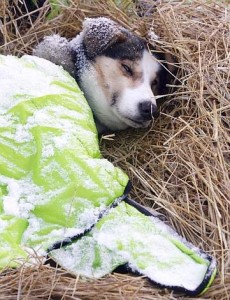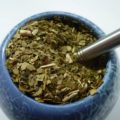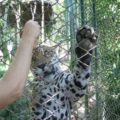
Cecilia is an Italian friend of Expatclic, and she lives in Anchorage, Alaska. In this very interesting article she tells us about the the annual race from Anchorage to Nome on the Iditarod trail, a race that has become a very important event in her hosting country.
A phrase like “dog is the man’s best friend” takes a new, fulfilling meaning when these furry friends are the sole companions in a long and grueling race across Alaska wilderness. It is more than 1100 snowy miles from Anchorage to Nome: this is the trail of the Iditarod, which has its beginning as a mail and supply route from the coast to the interior mining camps. Mail and supplies went in, gold came out: all via dog sled.
In 1925 part of the Iditarod trail became a life saving highway for an epidemic diphtheria that stricken Nome. Serum had to be brought in, again by intrepid dog mushers and their faithful hard-driving dogs. The first Iditarod took place in 1973, as a re-enactment of this epic memento.
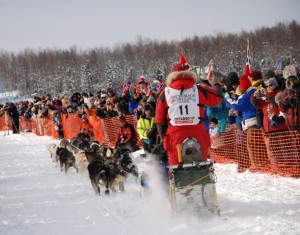 The race
The race
The race requires extraordinary efforts by the mushers and even more from the dogs, whose bootie-covered paws will beat the ground every inch of the way, pulling the loaded sled and their human partner.
Most are not standard Siberian Huskies, but a mix from a variety of Northern breeds, multicolored, sometimes spotted with different eye color, selected carefully for their attributes: an innate desire to run, stamina and double layers fur to withstand the cold.
A lot of them come from an old Native trap line dogs with a great deal of exposure through many generation to extreme conditions of Alaska. Every musher has his own tactic and strategy. Some prefer to run in daylight, some at night—since dogs can get too warm if they run when it’s 25°F, but dance in cold weather. As it could be expected with mixed breed dogs, they develop a variety of personality traits with one thing in common—all of them are literally high energy masses.
The bond between mushers and dogs
On the Iditarod mushers and dogs are dependent on each other, there’s an intense bond between them. No matter how tired a musher can be, when he arrives at a check point the first in his mind is to mend his dogs, give them food and grant each one some special attention— gently massaging paws, wrists and shoulders and sweet talking into their ears to keep up the morale, since dogs thrive on praise and human contact.
There is a second generation of mushers, whose family has been involved in the race since the beginning. For most of them to get ready, select and train the dogs and raise the money to get to Nome it’s an all year round job. The winner takes 69.000$ and a pickup truck. Substantial money prizes go down to 30st place. But it’s more like a passion or a commitment — every musher has his own reason to run the distance.
Thousands of volunteers
The race involves thousands of volunteers: men and women who help with hospitality, dog food and supplies, veterinarians, pilots, checkers and coordinators.
Veterinarians have a very significant role in the race, checking dog’s health condition at every check point and calling a dog out of the race if they find him ill or injured.
Last year I went to see the start for the first time. I must admit I had some issues about the dogs being pulled into this race and not treated well. I was wrong. The minute I saw these animals all barking and howling, bouncing up and down up to three feet off the ground while waiting impatiently for the sled to take off, I was progressively seduced.
Keeping 16 dogs running as a team cooperating every mile of the way, is a feeling that is likely incomprehensible to general population. This year I was waiting eagerly for it and I was familiar with the mushers (and dogs) names and personal records!
In Willow, where the re-start takes place, the general mood was very animated despite the 12F temperature. People were scattered on the huge icy lake and along the line where dogs would have passed. Teams were leaving one by one waving at the loud and cheering crowd, well aware of the loneliness of the future days.
In 2009 Iditarod suffered a bit for the global recession, resulting in less mushers running the race. This year’s race has been harsher than previous years, due to severe windstorms and the extreme cold along the coastal part of the trail. Nevertheless, the winner had been predictable from the first half of the race, when 2007 and 2008 champion Lance Mackey and his 15 dogs gained one check point of advantage over the other teams and held it till the end.
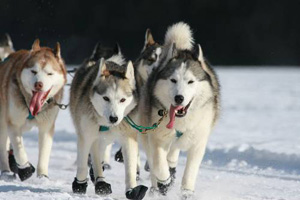 He was like a ghost—when his chasers arrived at the check point, he was already gone at the incredible speed of 8 to 10 Mph. Some mushers won the Iditarod more than once, but only three mushers (one of them was a woman: Susan Butcher) did it three times in a row and are now legendary names here in Alaska.
He was like a ghost—when his chasers arrived at the check point, he was already gone at the incredible speed of 8 to 10 Mph. Some mushers won the Iditarod more than once, but only three mushers (one of them was a woman: Susan Butcher) did it three times in a row and are now legendary names here in Alaska.
Iditarod is a unique race only possible in the vast landscape of Alaska. But ultimately, it is all about the dogs — their ability and power is unmatched.

